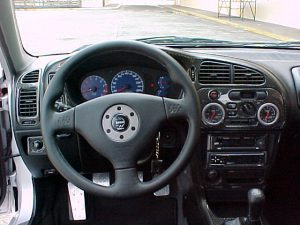WRC class cars
WRC class cars where introduced in 1997 following a FIA decision. Experience has proven that to win the WRC title a car has to be full time 4WD and, to a lesser extend, use a 2lt turbocharged engine. Not all manufacturers have (or are willing to have) such models in their line up. Additionally mass producing such cars, as “homologation specials“, is a risky financial adventure. This class of cars was thus introduced to allow any manufacturer to take part in the WRC with equal chances to success. The WRC class cars have to be produced to very limited numbers in order to get the required FIA homologation. Production numbers can be kept below 50 units (better still than back in the old Group B days where 200 units had to be produced). The typical WRC class car is based upon a large volume production model to which a manufacturer can modify or add the following:
- Modified front and rear suspension layout and attachment points
- Add-on turbocharger even if the production car does not have one
- Modified transmission and additional transmission tunnels in order to fit a 4×4 transmission even if the production car is 2 wheel drive. Consequently differentials and gear box are free.
- Modified engine intake and exhaust systems
- Modified engine position (the engine can be relocated by a maximum of 20mm as compared to its original position and can be tilted by 20¬į around the crankshaft axis)
- Modified wheelbase (¬Ī20mm) and track widths (1550mm max)
- The maximum car width allowed is 1770 mm
- Minimum length of 4000mm
Apart from the rules above the WRC class cars have to comply to the same rules as Group A class cars and are effectively their successors only modified to a greater extent. The WRC Class regulations allowed Subaru to produce the WRC version of the Impreza, Ford to produce the WRC Escort and Focus WRC, Peugeot the 206 WRC and Toyota the Corolla WRC. Subaru was at the origin of the new FIA regulations. David Richards (in charge of Prodrive the company that produces the rally versions of the Subaru Impreza) pressured to get the new car class homologated arguing that these cars would attract more people (spectators, TVs, etc.) to the World Rally Championship since the new cars were much more impressive. This argument proved arguable later as WRC class cars are essentially the same to older Group A cars with minor additional features. However one has to note that Subaru had already developed the WRC Impreza and this situation took the other teams by surprise. A better argument in favor of WRC cars is the fact that manufacturers have to produce only 50 units to get the FIA homologation hence less financial involvement is required. This fact has led numerous new manufacturers to produce WRC cars. Among them Seat with the Cordoba WRC, Peugeot with the 206 WRC, Ford with the Focus WRC and lately Hyundai and Skoda.
In 1997, while Mitsubishi and Ralliart, wisely, preferred not to produce a WRC version of the Lancer and stick with the Group A car, Ford Motorsport saw the new regulations, as soon as they where introduced, as a launching pad. The Ford Escort RS Cosworth suffered from a “weak” engine in its Group A version. Ford decided to junk the Garrett turbo charger and replace it with a lighter hybrid IHI model (like the one used in the Impreza). This choice later proved catastrophic. The company also heavily modified the suspension layouts, engine intake, exhaust and management in order to produce the WRC version of the Escort. Note that very few parts made their way from the Escort WRC car to the Focus WRC. Toyota introduced the Corolla WRC in the 1000 Lakes rally 1997. The company was absent, officially, from the WRC since their exclusion for cheating in 1995 when they raced the Celica GT4 in the Group A class.
The limited production numbers of WRC class cars reserves them solely to competition. No street legal, “homologation specials” are needed which means, of course, that you cannot buy one. Additionally works teams will not sell the latest evolution of their WRC class contender to a private rally team in the first year of the car’s existence for obvious reasons. Starting from the second year of WRC class car’s life, private teams can order WRC class models which are not as competitive or evolved as their works counterparts.
The cost of running with such a car is truly prohibitive to all but the top racing teams. A privately owned WRC car will be charged more than 350000 US$ to the buyer, the running costs for one season are twice that amount…engines are replaced after 1000Km of special stages, gearboxes and differentials are dismounted and verified after every race and most parts are replaced regularly but at least once every season.
WRC cars have to progress, technically, at an extremely rapid pace. A few weeks delay in developing the car can cost precious seconds/km and consequently the race. The technical presentations you’ll find in the car-specs sections and descriptions cannot keep up with their rapid evolution but they do provide you with an idea of what’s in the cars.
It becomes more and more clear that the WRC class cars have finally dominated all other classifications, including the kit car F2 one. Most European rally championships are now dominated by these cars which, in a way, have replaced the Group A cars of old.

